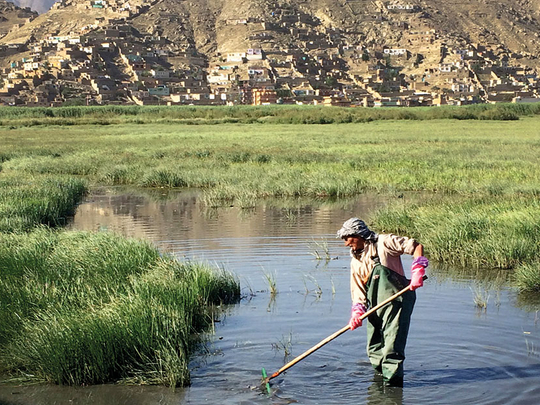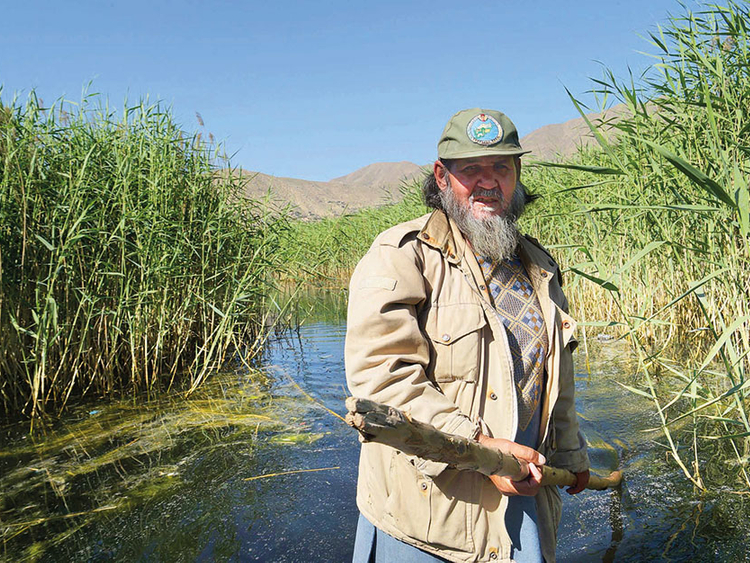
Kabul: Just south of the Afghan capital, on a busy road lined with car repair shops, goat corrals and garbage pits, a narrow lane opens unexpectedly onto a small natural wonder — a picturesque, nearly hidden marsh that is known only to a few Afghans and inhabited only by migratory birds and several families of wild dogs.
The 190-hectare site, known as Kol-e-Hashmat Khan, is one of the rare recognised wetland areas in central Afghanistan. Once it drew wealthy sightseers and royal hunting parties, but during four decades of war and turmoil it lay abandoned and neglected. The water filled with sludge, unauthorised settlements sprang up around the edges, and fewer birds stopped to rest or breed in the desiccated marsh.
Now, an ambitious effort to clean up and restore the site, launched several years ago by the Afghan government and local civic groups with support from the UN Environmental Program, is starting to bear fruit. Water from the nearby Logar River has been diverted with sandbags, and new reed growth has attracted an increasing number and variety of birds.
This month, the United Nations took a further step, declaring Kol-e-Hashmat Khan a protected conservation site and bird sanctuary, which could bring more funds and attention to efforts to save it. The site, also an important source of reservoir water for the capital region, dries up in certain months, and officials worry it could eventually disappear.
“Some of the birds stopping here travel from India to Siberia,” marvelled Arif Azimi, an engineer and civic activist, looking out over the marsh one recent morning as a wildlife ranger with binoculars pointed to several pairs of waterfowl flitting among the reeds. Last year, officials said, 157 different species were identified at the site — a healthy increase from a tally of 93 species in 2010.
But although environmentalists have made headway with efforts to preserve the site, they are also encountering indifference — and some resistance — from local residents and businesses. Several poor communities surrounding Kol-e-Hashmat Khan have been provided with garbage collection stations, but people keep dumping their trash into the marsh.
All morning, as Azimi and a group of visitors watched, two government workers wearing rubber boots and gloves waded through the knee-deep water, raking up debris and collecting it to be hauled off. But just a short distance away, where a row of mud-walled houses lines the marsh, children emerged periodically with buckets of household slops and tossed them into the water.
“We have put up the collection sites, and the municipal government has signs telling people to use them, but it doesn’t always happen,” Azimi said with a frown. He said mechanics also dump used oil and metal scraps at the wetlands site. “We do our best to make people aware, but we need more support,” he said. “It takes time to change people’s behaviour.”
Several international agencies and non-profit groups have worked for years to study and protect some of Afghanistan’s natural sites. The best known is the Wakhan Corridor, a 200-mile stretch of alpine valleys and rivers in the remote far northeast bordering China. Home to rare animal species including snow leopards, it has remained largely free of human development and interference.
But with the country mired in poverty, illiteracy and unresolved conflict, such projects can seem like luxuries — and in the more populous areas, human survival comes first. Most Afghan homes are heated by coal and wood stoves, and the mass cutting of trees for fuel has deforested provinces along the southeastern border with Pakistan. There has also been little effort to stop the illegal cross-border traffic in lumber.
Although the idea of wetlands as places of beauty and social value is not widely understood, efforts to support bird migration and breeding appear even more esoteric. In the 1970s, the Afghan government declared Kol-e-Hashmat Khan a nationally protected area, but the designation lost all meaning in the ensuing decades of conflict. It is now managed by the Ministry of Agriculture and Livestock, which built an education centre and observation deck there several years ago.
The site attracts experts and occasional groups of birdwatchers, and during the early-morning visit by Azimi, UN officials and several journalists, the wildlife ranger on duty eagerly named two dozen species of ducks, egrets and other waterfowl he had seen there this season. He said the number of visiting birds had been growing every spring, when the great south-north migrations take place and millions of birds must fly over the nearby Himalayan peaks.
“I was raised here, and I love this area and the river,” said the ranger, 34, who gave his name as Fareed. “Look over there — that’s a sauna khar, you can tell by the white chest. She’s the mother bird, and she has two babies in a nest in the reeds.”
Cleanup efforts have also begun to revive the fish population, he said, but he also pointed to mounds of discarded plastic bags clogging the water’s edge, noting that they contaminate the water and make it harder for aquatic life to survive. “That is all plastic fish food,” he said drily.
Environmental officials visiting the site said various approaches have been tried to improve public knowledge and participation in ecological activities, such as teaching housewives to make compost from kitchen waste, enlisting youth groups to collect trash and asking local mosque leaders to spread messages.
The results have been mixed, with some neighbourhoods around the marsh rejecting garbage stations and others ignoring them. Illegal land-grabbing has created congestion and contamination, open wastewater drains run into the marsh, and trash accumulates faster than workers can rake it away.
Several residents at Kol-e-Hashmat Khan said that they appreciate efforts to beautify the area but that they have their own daily problems to worry about. Sayed Rahman, 40, a mechanic whose workshop and home are a few yards from the marsh, acknowledged that he often dumps his work refuse there.
“We know this is a nice area of nature, and we’re happy the government is trying to keep it clean,” said Rahman, who built his family’s small house there a decade ago. “I have no place nearby to put the waste from my garage, so I put it in a bag, but unfortunately, its final destination is here.”
As he spoke, a small girl appeared in the doorway of the adjacent house, trudged wordlessly to the water’s edge, tipped her bucket of trash into the water, and trudged back inside.














